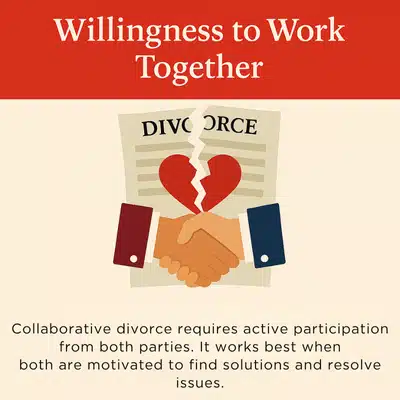Divorce can be challenging, but how you choose to divorce can make a big difference in the experience for you and your family under family law.
More couples seeking an amicable separation are exploring collaborative divorce as an alternative to traditional proceedings. This approach brings in other professionals to guide child custody planning and dividing assets, ensuring neither one party feels unheard. Such cooperation, transparency, and open communication distinguish traditional and collaborative divorce processes.
We will break down collaborative divorce vs traditional divorce, explain timelines, costs, and potential outcomes, and highlight key factors to consider so you can make an informed decision about the best path in 2025.
Collaborative divorce is a legal process designed to help spouses settle their divorce in a respectful, private, and non-adversarial manner, keeping proceedings out of the public record under family law guidelines. In Texas January filings, collaborative divorce is formally governed by law under Title 1A of the Texas Family Code, a cornerstone of family law statewide. The spouses and their attorneys commit to resolving all issues related outside of court, and the parties work together as a team to reach a mutually acceptable settlement for divorcing couples.
This divorce litigation often includes neutral professionals like financial experts, child specialists, or mental health coaches to provide additional expertise and support.

Participation Agreement: Both spouses and their collaborative divorce lawyers pledge good-faith negotiation and avoid traditional litigation. If either party abandons the collaborative divorce litigation for court action, the attorneys must withdraw and the spouses must hire new legal representation. This rule creates a strong incentive to settle within the collaborative divorce process.
Cooperative Negotiation: Joint meetings replace motions and proceedings, letting spouses and attorneys communicate openly. By applying interest-based conflict resolution, couples find common ground on child custody, property division, and support while keeping control of the divorce process instead of leaving decisions to a judge.
Collaborative Team Approach: Neutral professionals such as financial pros, child specialists, and divorce coaches join the team to provide data, craft co-parenting plans, and manage stress. Their guidance reduces legal fees, fosters mutual respect, and keeps everything moving forward.
Privacy and Confidentiality: A collaborative divorce takes place in private conference rooms or over video calls, so sensitive personal and financial details stay out of the public record. This confidentiality, unavailable in traditional divorce, protects family welfare and encourages customized solutions that support long-term stability.
By contrast, traditional divorce typically means a court-based process, often referred to as divorce litigation or contested divorce. Each spouse may hire their own attorney to advocate for their individual interests in a classic adversarial setup. If the spouses cannot reach an out-of-court agreement on issues like property division, child custody, and child support, the dispute will proceed through the court system for a judge to make the final decision.
Traditional divorce often involves formal procedures such as filing a lawsuit, exchanging evidence through discovery, motions and hearings, settlement negotiations between lawyers, and potentially a trial where each side presents their case.
Public Court Proceedings: Traditional divorce entails filing documents and arguing in open court. These court proceedings and filings become public court record, and divorcing couples should remember that the dissolution of a marriage will be visible to all parties involved.
Adversarial Nature: The litigation process positions spouses as opponents. Each side’s attorney must zealously represent a client’s best interests, which can amplify conflict. Traditional divorce often evolves into contentious court battles, and prolonged litigation may further strain the marriage and the relationship between the parties.
Judicial Decision Making Power: In traditional divorce, if spouses cannot agree, unresolved issues go before a judge. This means relinquishing control to the court system. While the court strives for fairness, the final outcome may not feel personally tailored to the unique circumstances of the marriage.
Traditional divorce remains the default route when one or both spouses refuse to cooperate or when complex disputes cannot be resolved informally. It provides the structure of the legal system, including power to compel disclosures and issue orders affecting both parties such as restraining orders.
Both collaborative divorce and traditional divorce ultimately lead to the same result – a legally binding divorce decree – but the journey differs dramatically.

Traditional divorce is often characterized by an adversarial approach where each spouse stakes out demands through their lawyer, positioning the parties as opponents. In contrast, collaborative divorce under collaborative law adopts a cooperative approach where spouses and collaborative law trained attorneys agree from the outset to seek common ground.
The tone of collaborative meetings is respectful and solution oriented, a hallmark of collaborative divorce within collaborative law that reduces conflict and eases emotional strain on all parties.
In collaborative divorce, the parties maintain control over all decisions. Nothing gets finalized unless both spouses agree to it. You and your spouse, with guidance from your team, craft a settlement that you both find acceptable.
Couples can get creative and come up with customized solutions that a court might not typically order. By contrast, in traditional divorce, ultimate decision making power lies with the judge if you cannot agree on your own.
Privacy is a major differentiator. Collaborative divorce happens in private settings, and the details remain confidential. In traditional divorce, many documents become public domain.
Collaborative divorce can be more cost-effective than a drawn-out court fight, primarily because it may resolve issues with lower legal fees. By cooperating, parties often avoid excessive discovery disputes and repetitive appearances.
In litigated divorce, attorneys are often seen as warriors strategizing against each other. In collaborative divorce, collaborative divorce lawyers take on the role of settlement specialists and teammates. They work together with the other side to resolve conflicts rather than fight.
Every divorcing couples’ circumstances are different. Here are key considerations when deciding between collaborative divorce and traditional divorce:

Collaborative divorce requires active participation in good faith from both parties. It works best when both spouses are motivated to find solutions and resolve issues amicably. If you both share a goal of keeping things low-conflict for the sake of the family, that leans toward a collaborative approach.
If one spouse is completely uncooperative or intent on dragging matters out as revenge, then collaboration likely won’t succeed. In such cases, traditional court action may be necessary.
Collaborative divorces shine in cases where creative solutions are needed. If you have complicated assets or intricate financial arrangements, the collaborative team can include neutral financial experts to help devise solutions.
The collaborative process is useful for interest-based solutions that a court might not have authority to impose. In contrast, if your situation is fairly simple, you might not need the full team approach.
Collaborative sessions require emotional control and willingness to listen to the other side. However, if there’s a history of domestic abuse, intimidation, or severe power imbalance, a one-room negotiation may not be appropriate.
Victims of abuse might not feel safe in a collaborative setting. In such cases, the process is usually recommended for safety and fairness.
If you have children, you and your spouse will be co-parents for life. Many couples prioritize ending the marriage in a way that preserves a working relationship. Collaborative divorce is specifically geared toward fostering mutual respect and understanding, which can set the stage for better co parenting.
The process aims to set a positive track for the family’s future interactions, focusing on the best interests and well being of children involved.
One crucial consideration is what happens if collaborative divorce fails to produce an agreement. If spouses reach an impasse after weeks or months of meetings, the collaborative process terminates. The collaborative attorneys must withdraw, and the spouses would then move to traditional divorce with new legal representation.
While this scenario is not ideal, it’s not common. Studies show that most collaborative divorces are successful in reaching full settlement. An extensive study found that about 86% of collaborative cases ended in full agreement.

Deciding between collaborative or traditional divorce comes down to understanding these differences and honestly evaluating which approach aligns with your situation. A couple on relatively good terms, aiming for a respectful split, will likely benefit from the collaborative process.
In cases involving serious conflicts or domestic abuse, the structure and protection of the process may be necessary for a fair outcome.
If you’re unsure which path to take, seek advice from an experienced family law attorney who can assess the specifics of your case. Many attorneys are trained in both collaborative law and traditional litigation.
Divorce is never easy, but it doesn’t have to destroy your family relationships or finances. Collaborative divorce offers numerous benefits for couples who can cooperate – privacy, control over outcomes, potentially lower conflict and cost, and focus on family well being.
Traditional divorce may be necessary when cooperation isn’t possible or legal intervention is needed to protect rights. By weighing these factors and consulting with a knowledgeable attorney, you can choose the divorce method that best suits your situation.
Ready to explore your divorce options? Contact us today for an initial consultation to discuss which approach is in your best interests and those of your family.